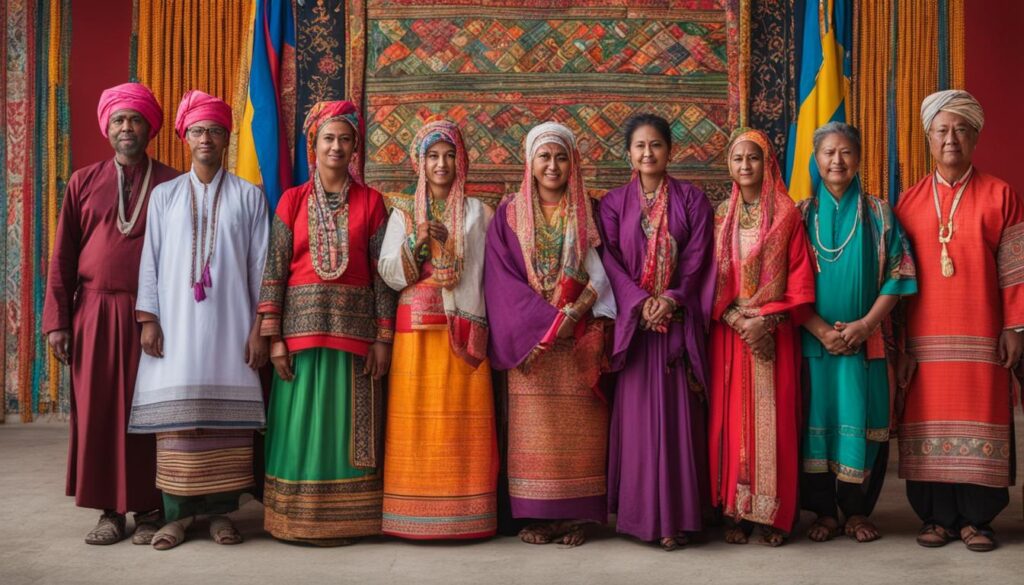Effective communication involves much more than just words. In today’s diverse and interconnected world, it’s crucial to understand the impact of nonverbal communication and cultural sensitivity on cross-cultural interactions and relationships. By developing your cultural intelligence and mastering nonverbal cues, you’ll be better equipped to navigate different cultural landscapes and establish deeper connections with people from all walks of life.
Defining Nonverbal Communication
Nonverbal communication refers to the transmission of information through non-linguistic and non-written forms. It involves the use of various nonverbal cues and behaviors, including body language, facial expressions, gestures, and proxemics (the use of personal space).
Nonverbal communication is a fundamental part of human interaction and is present in all forms of communication, from one-on-one conversations to public speeches. It can convey a range of emotions, including happiness, sadness, anger, and fear, and can also express attitudes and intentions.
Understanding nonverbal communication is essential for effective communication, especially in cross-cultural settings where cultural norms and values can influence interpretation and understanding. By mastering nonverbal cues, you can improve your communication skills and build rapport with others.
“The most important thing in communication is hearing what isn’t said.” – Peter Drucker
The Role of Cultural Sensitivity in Communication
Cultural sensitivity plays a critical role in establishing effective communication in diverse settings. It requires an understanding and awareness of cultural differences, values, beliefs, and practices. Being culturally sensitive means recognizing and respecting these differences and adapting our communication style to match the norms and expectations of different cultures.
Why is this important? Without cultural sensitivity, we risk unintentionally causing offense or misunderstanding. For example, nonverbal cues such as gestures and facial expressions can vary widely across different cultures. What might be considered polite or respectful in one culture could be perceived as rude or aggressive in another. By being culturally sensitive, we can avoid such misunderstandings and build stronger, more inclusive relationships with people from diverse backgrounds.
One key aspect of cultural sensitivity is cultural awareness. This involves acknowledging and learning about different cultural practices and beliefs. By understanding the values and perspectives of different cultures, we can adapt our communication style to build trust and rapport with people from diverse backgrounds.
“Cultural awareness is the foundation of communication and it involves the ability of standing back from ourselves and becoming aware of our cultural values, beliefs, and perceptions.” – Edward T. Hall
Examples of Cultural Sensitivity in Communication
Here are some examples of how cultural sensitivity can impact communication:
| High Cultural Sensitivity | Low Cultural Sensitivity | |
|---|---|---|
| Body Language | Adapts body language to match cultural norms and expectations | Uses the same body language across cultures, potentially causing confusion or offense |
| Eye Contact | Recognizes that eye contact can have different meanings in different cultures and adjusts accordingly | Maintains constant eye contact, which could be seen as confrontational or disrespectful in some cultures |
| Greeting | Researches and understands appropriate greetings for different cultures and situations | Uses the same greeting for everyone, regardless of cultural background |
By striving to be culturally sensitive in our communication, we can create a more inclusive and respectful environment, fostering positive relationships across cultures.
Nonverbal Communication Across Cultures
Nonverbal communication, such as facial expressions, gestures, and body language, plays a crucial role in intercultural communication. However, these nonverbal cues can vary greatly between cultures, leading to misunderstandings and misinterpretations.
For example, in some cultures, direct eye contact is a sign of respect and engagement, while in others, it may be seen as a sign of disrespect or aggression. Similarly, some cultures may use physical touch as a form of communication, while others may view it as inappropriate or invasive.
Therefore, it is essential to be culturally sensitive and aware of these nonverbal communication differences when interacting with individuals from different cultures. Cultural intelligence is key to being able to recognize and adapt to these differences, thus creating a more effective and positive intercultural communication experience.
Cultural Variations in Nonverbal Communication
A study conducted by researchers at the University of California found that cultural norms strongly influence nonverbal communication. The study concluded that there are significant variations in the interpretation and display of facial expressions and body language across cultures.
| Culture | Nonverbal Cues |
|---|---|
| Japan | Subtle facial expressions, limited physical contact, indirect communication style. |
| United States | Loud voice, direct eye contact, physical touch, frequent gesturing. |
| Spain | Physical contact, expressive gestures, direct communication style. |
As shown in the table above, nonverbal communication can vary significantly between cultures. Thus, it is important to approach intercultural communication with an open mind and sensitivity to cultural differences.
Developing Cultural Intelligence for Effective Nonverbal Communication
“Cultural sensitivity is vital for effective nonverbal communication across cultures. Building cultural intelligence helps you recognize and adapt to nonverbal cues from different cultures.”
Developing cultural intelligence involves actively learning, observing, and respecting different cultural norms and values. By being attentive to nonverbal communication cues and adapting your communication style accordingly, you can improve your intercultural communication skills and build stronger relationships.
In summary, cultural sensitivity is critical to effective nonverbal communication across cultures. By recognizing and respecting cultural differences in nonverbal communication, you can build more positive and productive intercultural relationships.
Key Nonverbal Cues in Different Cultures
Cross-cultural communication can be challenging, especially when it comes to interpreting nonverbal cues. In different societies, nonverbal behaviors such as gestures, facial expressions, eye contact, and body language can have various meanings. Hence, it’s crucial to understand and recognize these cultural nuances to avoid misunderstandings and promote effective intercultural communication.
Here are some key nonverbal cues in different cultures:
| Culture | Nonverbal Cues | Meanings |
|---|---|---|
| Japan | Bowing | A sign of respect and gratitude |
| Brazil | Touching | A sign of warmth and friendliness |
| Middle East | Prolonged eye contact | A sign of interest and respect |
| India | Nodding | Signals understanding and agreement |
| USA | Handshakes | Shows politeness and professionalism |
However, these nonverbal cues are not universal and can vary based on regional, ethnic, and individual differences. Thus, it’s crucial to avoid making assumptions and develop cultural sensitivity when interacting with individuals from different cultures.
In the next section, we will discuss practical strategies for enhancing cultural sensitivity through nonverbal communication.
Enhancing Cultural Sensitivity through Nonverbal Communication
As discussed earlier, cultural sensitivity is a crucial aspect of effective intercultural communication. Nonverbal communication plays a significant role in promoting cultural sensitivity in diverse settings.
Here are some practical strategies for enhancing cultural sensitivity through nonverbal communication:
- Active Listening: One way to enhance cultural sensitivity is by actively listening to what others have to say. Pay attention to the speaker’s tone of voice, facial expressions, and body language to better understand their perspective.
- Empathy: Putting yourself in others’ shoes is important for developing cultural sensitivity. Try to understand their cultural background and how it shapes their behavior and communication style.
- Adapting to Cultural Norms: Be aware of cultural norms and adjust your behavior accordingly to avoid misunderstandings or offending others. For example, in some cultures, direct eye contact is considered disrespectful, while in others, it is seen as a sign of attentiveness.
By implementing these strategies, you can improve your nonverbal communication skills, which will enhance your cultural sensitivity and promote positive intercultural interactions.
Overcoming Barriers in Intercultural Communication
Cultural differences can create challenging barriers to effective intercultural communication. Language, customs, and beliefs can all contribute to misunderstandings and misinterpretations, leading to frustration, offense, and even conflict. However, developing cultural sensitivity and intelligence can facilitate successful cross-cultural interactions and relationships.
One of the key barriers to intercultural communication is language. Without a shared language, conveying ideas and emotions accurately can be difficult. Nonverbal communication can offer some support in this regard, but cultural differences in nonverbal cues can further complicate communication. Additionally, different cultural norms around appropriate levels of directness, formality, and politeness can cause misunderstandings.
Cultural sensitivity and intelligence can help overcome language and other intercultural communication barriers. By understanding and respecting cultural differences, you can adapt your communication style and approach, ensuring greater clarity and mutual understanding. Empathy and active listening are also important tools for bridging cultural divides, facilitating more meaningful conversations and relationships.
“Communication works for those who work at it.”
– John Powell
Additionally, developing an awareness of your own cultural biases and assumptions can help you stay open to alternative perspectives and ways of communicating. By recognizing your own cultural context, you can become more aware of how it shapes your approach to communication and adjust accordingly.
Key Takeaways
- Cultural differences can create barriers to effective intercultural communication.
- Language barriers, nonverbal cues, and cultural norms can all contribute to misunderstandings.
- Developing cultural sensitivity and intelligence can help overcome these barriers.
- Active listening, empathy, and awareness of your own cultural biases are essential tools for successful intercultural communication.
Nonverbal Communication in Professional Settings
In today’s globalized business world, effective cross-cultural communication skills are essential for success. Nonverbal communication plays a crucial role in workplace interactions, influencing the way we perceive and interact with others. Developing cultural sensitivity and understanding nonverbal cues can help you build trust, establish meaningful connections, and navigate cultural differences.
One of the most critical aspects of nonverbal communication in professional settings is body language. Our gestures, facial expressions, and postures can convey subtle messages that impact our relationships with colleagues and clients. Understanding cultural differences in body language can allow you to adapt your nonverbal behavior to match expectations and avoid potential misunderstandings. For example, direct eye contact is generally considered a sign of attentiveness and respect in Western cultures but can be seen as confrontational in other cultures.
Cultural sensitivity is also essential when it comes to nonverbal communication in the workplace. Emphasizing cultural awareness and respect can help foster inclusivity and create a welcoming environment for all team members. By understanding and valuing diverse cultural expressions, you can build strong relationships with people from different backgrounds and enhance collaboration and innovation within your organization.
In summary, developing cultural sensitivity and understanding nonverbal cues are critical in professional settings. By recognizing the impact of nonverbal communication on workplace interactions and relationships, you can adapt your behavior, build trust and rapport, and navigate cultural differences effectively.
Developing Cultural Intelligence for Effective Communication
Effective intercultural communication requires not only cultural sensitivity but also cultural intelligence. Cultural intelligence is the ability to understand and navigate diverse cultural contexts, adapt to cultural norms, and communicate effectively with people from different cultural backgrounds. Developing cultural intelligence enhances your cultural sensitivity and improves your ability to establish positive relationships across cultures.
How to Develop Cultural Intelligence
To increase your cultural intelligence, you can follow these simple steps:
- Learn about different cultures: Gather information about the customs, traditions, values, and beliefs of other cultures to better understand their perspective.
- Be curious and open-minded: Avoid making assumptions and be willing to learn and ask questions about other cultures without imposing your own beliefs and values on them.
- Develop empathy: Put yourself in other people’s shoes and try to understand their feelings and experiences.
- Practice cultural self-awareness: Reflect on your own cultural biases and assumptions that may affect your communication with people from other cultures.
- Adapt to cultural norms: Be respectful of other cultures’ customs, communication styles, and social etiquettes, and try to adapt your behavior accordingly.
The Benefits of Cultural Intelligence
Developing cultural intelligence can help you become a more effective communicator in various aspects of life, including personal, social, and professional settings. It helps you:
- Establish trust and build relationships with people from other cultures
- Minimize misunderstandings and conflicts caused by cultural differences
- Improve your problem-solving and decision-making skills in multicultural environments
- Gain a competitive edge in the global marketplace
Nonverbal Communication Pitfalls to Avoid
When it comes to nonverbal communication in cross-cultural settings, there are several common pitfalls and misunderstandings that can undermine effective communication. By understanding these challenges, you can minimize misinterpretation and navigate intercultural communication more effectively. Here are some nonverbal communication pitfalls to avoid:
Assuming Universality
One of the biggest mistakes you can make in cross-cultural communication is assuming that nonverbal cues and behaviors are universal. Different cultures may have varying interpretations of nonverbal cues such as eye contact, hand gestures, or physical touch. For example, in some cultures, prolonged eye contact may be seen as a sign of respect and attentiveness, while in others, it may be perceived as a sign of aggression or disrespect. It is essential to be aware of these cultural differences and understand their nuances.
Ignoring Cultural Context
Another common mistake is ignoring the cultural context when interpreting nonverbal cues. For example, a smile in one culture may indicate happiness, while in another, it may indicate nervousness or embarrassment. Therefore, it is essential to consider the cultural context when interpreting nonverbal cues. Cultural sensitivity and awareness can help you navigate these differences and avoid misunderstandings.
Equating Similarity with Understanding
Assuming that people from similar cultures share the same nonverbal cues can also be a pitfall in intercultural communication. People may have individual differences in their nonverbal communication styles, even within the same culture. Therefore, it is crucial to avoid stereotyping and instead focus on understanding the individual and their unique communication style.
Remember, nonverbal communication is integral to intercultural communication. By avoiding these common pitfalls and developing cultural sensitivity, you can strengthen your ability to navigate nonverbal communication successfully.
Strengthening Intercultural Relationships
Establishing strong intercultural relationships requires effective communication, cultural sensitivity, and continuous learning to build meaningful connections across cultures. Developing cultural intelligence can help you navigate diverse landscapes and promote mutual respect and empathy.
When communicating with individuals from a different cultural background, it’s crucial to keep an open mind and be receptive to their customs and traditions. Avoid making assumptions or passing judgment, and instead, seek to understand their perspectives and values.
Cultural sensitivity plays a significant role in developing strong intercultural relationships. It allows you to recognize and appreciate diverse backgrounds and fosters an inclusive and welcoming environment. By upholding cultural sensitivity, you can avoid misunderstandings that may arise due to differences in nonverbal communication and body language cues.
“Cultural differences should not separate us from each other, but rather cultural diversity brings a collective strength that can benefit all humanity.” – Robert Alan
Building strong intercultural relationships also requires continuous learning and adapting to new cultural settings. Take the time to educate yourself on different cultures and their customs, which can help you better communicate and connect with individuals from diverse backgrounds.
In summary, building strong intercultural relationships is a continuous process that requires cultural sensitivity, effective communication, and continuous learning. Upholding cultural intelligence fosters mutual respect and empathy to establish meaningful connections across cultures.
Conclusion
In conclusion, understanding nonverbal communication and cultural sensitivity is crucial in establishing effective intercultural interactions and relationships. By recognizing the impact of nonverbal cues, body language, and cultural awareness on cross-cultural communication, you can navigate diverse cultural landscapes more effectively.
Developing cultural intelligence is vital to improving your intercultural communication skills. This involves actively listening, showing empathy, and adapting to cultural norms to foster positive intercultural interactions. Remember to avoid common pitfalls and misunderstandings in nonverbal communication across cultures.
By continuously improving your cultural sensitivity and communication skills, you can strengthen your intercultural relationships and establish meaningful connections across cultures. It all begins with recognizing the importance of nonverbal communication and cultural sensitivity in promoting inclusivity in diverse settings.

















































